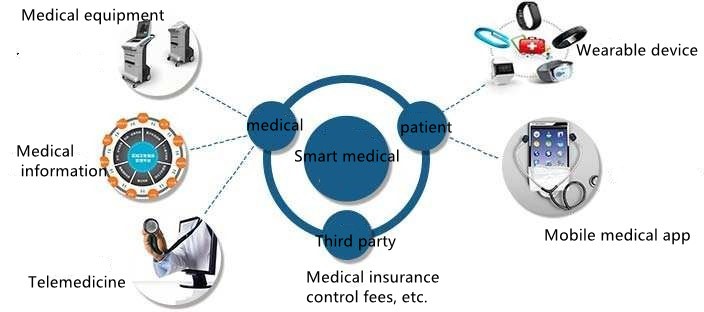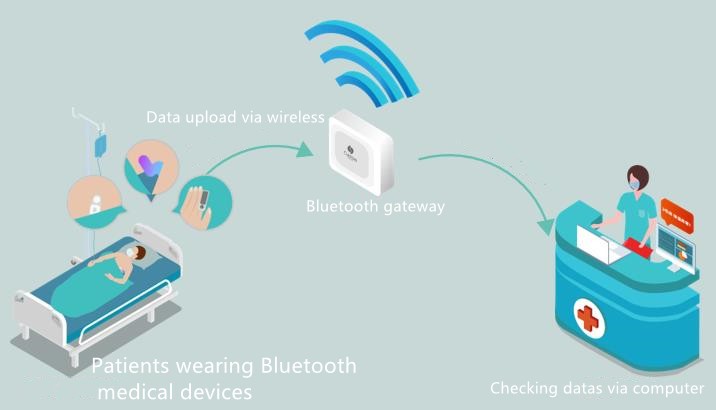The application of Bluetooth technology in medical equipment is mainly to replace wired connections.
Why use Bluetooth instead of wired connection in medical equipment?
1. Each medical equipment in the hospital is basically an independent system. Therefore, various equipments are equipped with their own computer systems and peripheral systems such as printers. They are all connected with data lines independently. Therefore, read the machine status and reconfigure the equipment. Sensor data, patient data, patient monitoring, security access data, asset tracking, etc., are all independent systems for security considerations. The most common phenomena are operating rooms and radiology departments. You can see that there are cable connections everywhere, staggered and scattered. On the ground, once there is an instrument failure, it will take doctors a lot of effort to check whether each interface is connected along the wires. It takes a lot of time to arrange the wires. This wastes a lot of time. Time is very precious to rescue patients and language. After each device is connected with Bluetooth technology, it solves the trouble of medical device users.
2. Some medical instruments, such as electrophysiological instruments such as electroencephalogram and electrocardiogram, receive electrical signals from the patient's body surface, and transmit the bioelectric signals to medical equipment through cables for analysis. Meanwhile, because the cable connection restricts the patient's position and movement, the patient can only undergo a physical examination in the lying position, so it is impossible to understand the bioelectric signal of the patient's activity in a certain range in other positions, or even in the state of exercise.
3. Some medical restricted areas, such as laminar flow ward, operating room, radiography room, radiotherapy room, rescue room, etc., are not suitable for all medical personnel to enter and exit. There must be a strict isolation system. Bluetooth can play a very good role in these places. The role of the doctor can make some examinations and treatments wireless remote control, reducing the probability of staff directly in and out, and at the same time does not hinder the doctor's treatment and consultation work.
What are the conditions for Bluetooth connection in electronic medical equipment?
A. In multi-machine communication, it is necessary to ensure reliable communication between the master and the selected slave, and the communication interface must have a strong recognition ability. For Bluetooth multi-machine communication, it is more susceptible to interference, so in addition to requiring as little external interference as possible. In addition, a more reliable communication protocol is also required.
B. The composition of the Bluetooth protocol: As an open short-distance high-speed communication standard, the Bluetooth protocol mainly includes the following four aspects: Bluetooth core protocol (BB, LMP, L2CAP, SDP), cable replacement protocol (RFCOMM), telephone control protocol (TSC Binary, AT command set) and optional protocols (PPP, TCP/IP, DUP/IP, OBEX, WAP, ...). According to specific applications, the Bluetooth protocol can be flexibly configured, and it is encouraged to use various high-level protocols as much as possible to ensure the integration of existing network technology and Bluetooth technology. Therefore, in addition to the Bluetooth core protocol is necessary, the other three protocols are determined according to the specific needs of the application.
C. Requirements and realization of the transmission of physiological electrical signals: Physiological electrical signals are electrical signals that are converted into specific features produced by the organism, tissues, organs, cells and other systems in the life of an organism, reflecting the details of specific life activities. Here mainly refers to the Bluetooth data transmission for one-dimensional physiological telecommunication, such as: heart sound, electrocardiogram, brain electricity, myoelectricity, gastric electricity, and blood pressure, pulse, respiration and other physiological parameters converted into electrical signals.
According to the frequency range of the signal, it can be divided into three categories: (1) low-frequency signal, that is, the highest frequency is less than 250Hz, represented by ECG; (2) medium and high-frequency signals, mainly heart sounds; (3) broadband high-frequency signals, which refer to electromyography . Since Bluetooth has 7 types of ACL data packets, the ones with 2 check mechanisms suitable for physiological signals are DMI, DM3, and DM5 packets. In 8-bit or 12-bit sampling systems, low-frequency signals such as ECG should use DM1 data. For grouping, the heart sound signal should adopt DM3 data grouping, and the EMG signal should adopt DM5 data grouping.

The realization of Bluetooth in medical electronic equipment:
1. Suppression of radio electromagnetic interference: Bluetooth works in the global 2.4GHz ISM (ie, industrial, scientific, and medical) frequency band. The data rate of Bluetooth is 1Mb/s. Frequency hopping technology divides the frequency band into several hopping channels (Hop channel). In a connection, the radio transceiver continuously changes from one channel to the channel according to a certain code sequence (pseudo-random code). For another communication channel, the receiving and sending parties in the Bluetooth system communicate according to this rule, while other radio equipment cannot work according to the same rule. Therefore, the radio is largely suppressed.
2. Establish a "personal areanet": Bluetooth uses spread spectrum technology to minimize the impact of noise in the entire Bluetooth frequency band. Compared with other systems working in the same frequency band, Bluetooth frequency modulation is faster. Compared with other wireless communication devices, Bluetooth devices have low power consumption. The link distance of the radio transceiver of Bluetooth technology can reach 10 meters. The use of high-gain antennas can Extend the effective communication range to 100 meters. Not limited to a straight line, even if the devices are not in the same room, they can be linked to each other, and multiple devices can be linked, up to 7 activities, and up to 200 online devices, so that all the devices around the user can be linked To form a "personal micro-network."
3. Do not affect the bioelectric signal: Bluetooth technology has the advantages of stable transmission signal, not easy to be interfered and not hindered by objects. Under normal circumstances, Bluetooth technology can effectively replace the medical sensors and analysis on the patient in the traditional ward monitoring system Cables between analysis equipment such as instruments, PDAs and computers.
Wireless real-time monitoring of human life parameters is the common desire of doctors and patients, but it has unavoidable shortcomings based on traditional electronic technology. Bluetooth can not only replace the data cables around the personal computer, but also meet the wireless needs of patients in the intensive care unit. Through the ward Bluetooth gateway, a seamless connection between the Bluetooth monitoring network and the wired local area network can be realized, thereby combining the advantages of a variety of different networks, and bringing patients a simple and comfortable environment.

The safety of using Bluetooth:
The use of any medical equipment must be absolutely safe for people before it can be put into clinical use and be accepted by both doctors and patients. Security includes information security and ecological security.
1. Information Security
Experiments have proved that the use of microwave ovens will slow down the data transmission speed by 300k/s. In addition, spread spectrum equipment, frequency hopping equipment, wireless LAN, etc. will slow down the data transmission speed. However, the International SIG has done experiments in various environments. Low-power Bluetooth products have minimal interference to other similar products. On the contrary, the interference of other products to Bluetooth can be solved by software or hardware methods. Therefore, the problem of information security is more emphasized in the software protocol stack, and the software engineer is the main solution.
2. Ecological security
Ecological safety issues refer to whether the Bluetooth device is dangerous when it is close to the human body, mainly whether there is ionizing radiation, etc. This is a very sensitive issue for both doctors and patients who use it. A team composed of experts such as the World Health Organization and IEEE stated that no radiation from Bluetooth products was found to have an impact on the human body during the test. The problem of Bluetooth is mainly due to the fact that Bluetooth uses the same frequency range as microwave ovens. Although it is still unconclusive, some organizations believe that the output power of Bluetooth is very small, only 1mW, which is a millionth of the power used by microwave ovens. One is only a fraction of the radiation of a mobile phone, and only a small part of these outputs is absorbed by the object, and there is basically no local temperature increase detected. Since the ideal connection range of Bluetooth is 5 cm to 5 meters, the distance can be extended to 100 meters by increasing the transmission level. Therefore, the output power of Bluetooth can be further reduced and the connection range can be shortened as needed, which is more secure NS.
The opportunities for Bluetooth to replace existing wired systems are increasing, and the development speed will be relatively fast in the short term. Although the speed of increasing production capacity through wireless connection is slow, it has great long-term potential and good development prospects.